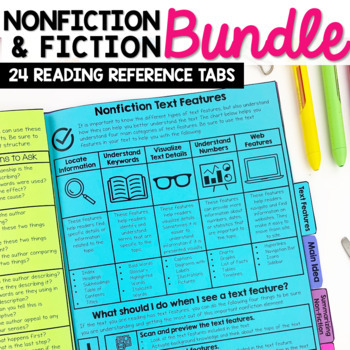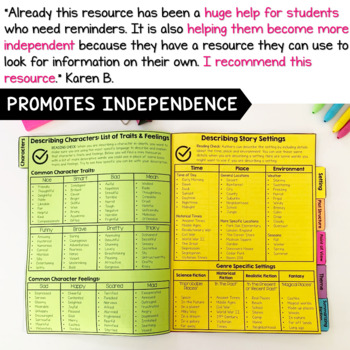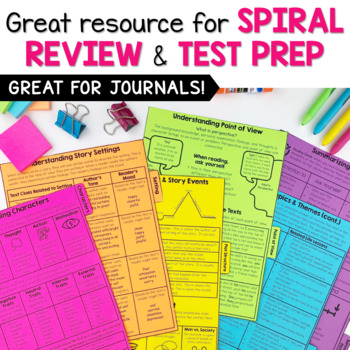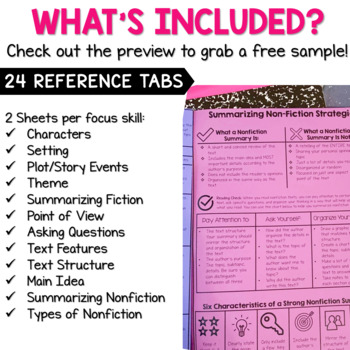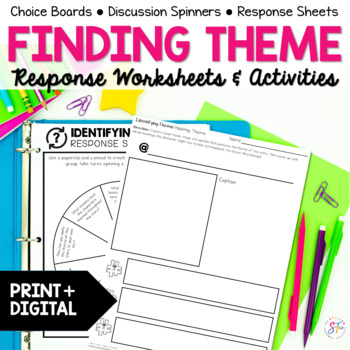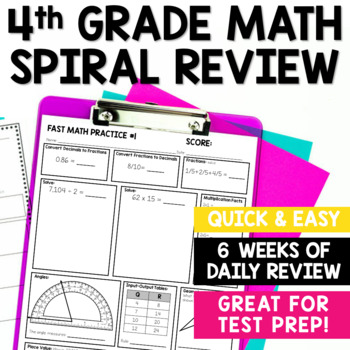Get 24 student-friendly reading comprehension reference charts in this fiction and nonfiction bundle. These ready-to-print reading reference charts will help your students understand both fiction and nonfiction texts. From knowing how to describe characters and setting to being able to find the theme and summarize fiction texts. Or if your students reading nonfiction, these charts will help them identify and use text features, find the main idea, and figure out the text structure. These reference tabs will become the best “helper” for your students when they are reading independently.
Reading Comprehension Reference Sheets
More about this resource
Get 24 student-friendly reading comprehension reference charts in this fiction and nonfiction bundle. These ready-to-print reading reference charts will help your students understand both fiction and nonfiction texts. From knowing how to describe characters and setting to being able to find the theme and summarize fiction texts. Or if your students reading nonfiction, these charts will help them identify and use text features, find the main idea, and figure out the text structure. These reference tabs will become the best “helper” for your students when they are reading independently.
If you teach 3rd, 4th, and 5th graders then you know that there is A LOT that goes into teaching reading. There are so many comprehension skills and strategies we need to teach our students. And even if you have the most beautiful and effective lesson, sometimes students need a resource to refer back to after the lesson when they are working independently.
These reference tabs include all the key reading concepts you’ll be teaching your students this year. And in this one-stop-reference-stop students can look back and be reminded of strategies, skills, questions, and vocabulary terms you taught them during your reading lessons.
Students love how independent and confident they feel when using these reference tabs.
THIS BUNDLE INCLUDES:
⭐️ Elements of Fiction Reading Reference Tabs
⭐️ Nonfiction Reading reference Tabs
Glue them in students’ reading journals or interactive notebooks or create a standalone reference book. The contents on these reference tabs will help your students become more independent and confident readers.
Included in each set of reference tabs:
- 2 Reference sheets per skill (12 total skills included in the bundle).
- Printing option for reference tabs to add to student journals
- Front and back printing option to create a student reference book
- Tabs include key vocabulary words, question stems, graphic organizer templates, step-by-step strategies, and other helpful information related to understanding fiction and nonfiction texts.
These reference tabs are a great tool to share with students. Here are a few ideas on how you can make them work in your classroom.
- Give students a copy to glue in their journals as you teach each reading skill. Throughout the year they will be building out their reference journal.
- Staple all the reference sheets together and give students a reference book when you begin your spiral review or test prep.
- Send home a copy of the reference sheets with students so they have a tool to use when they are reading or working on homework at home.
- Have a copy (or three) at your small group table for students to use during your small group lessons.
WHAT IS COVERED IN THE NONFICTION SET?
Asking Questions:
- Type of Questions – a chart with an explanation, examples of where to find evidence, and examples of questions for four types of questions (right there, think and search, inferential, on my own).
- Asking Questions Before, During, and After – A list of questions students can ask before, during, and after reading nonfiction texts
- Purpose of Question Chart – A chart with 12 different purposes and examples of questions for each purpose for questioning
Text Structure:
- Nonfiction Text Structure Chart – lists each type of text structure, provides an explanation, gives examples of key words, and shows a visual cue reminder
- Multiple Structures – provides students with a checklist of things they should do when they encounter a text with more than one text structure.
- Text Structure Examples and Questions – provides a written example of each type of text structure and includes questions students could ask when they see that text structure on their own
Text Features:
- 5 Categories of Text Features – provides a chart with examples and explanations for 5 ways text features can be used (to make words pop, to locate information, to visualize details, to highlight important numbers, web features)
- 4 Steps to Analyzing Text Features – provides a 4 step process for what students should do when they see a text feature in their text (scan and preview, study, question, evaluate)
- Text Feature Chart – Includes a chart with a list of common text features. Provides a definition of the text feature and includes questions to ask when students see that text feature in their own text.
Main Idea: (Free sample included in the preview.)
- Finding Main Idea – provides 4 strategies students could use to identify the main idea of a text.
- Topic, Main Idea, Details Chart – explains the difference and relationship between the topic, main idea, and details in the text. Gives an example of each and shows students what to look for to identify them in their own texts
Summarizing Nonfiction:
- Summarizing Nonfiction – a chart that shows what a nonfiction summary is and what it isn’t
- Summarizing Nonfiction – a chart that shows what to pay attention to, questions to ask, and how to organize your thinking to help summarize nonfiction text
- 6 Traits of a Nonfiction Summary – provides a brief explanation of the six attributes that make a clear nonfiction summary (keep it short, state the main idea, include a few details, include the author’s purpose, mirror the text structure, use your own words)
- Summarizing Nonfiction Strategies – includes a chart with 4 strategies students can use to help them summarize nonfiction texts (TAMKO, 5W questions, Text Structure Summary, Summarizing Sections)
Types of Nonfiction:
- Types of Nonfiction – includes a chart that explains the difference between biographical, reference, and narrative nonfiction
- DEAL strategy – helps students understand how to describe, explain, and compare and contrast relationships in nonfiction texts
- Author’s Purpose – gives students a set of questions to consider when thinking about the author’s purpose for writing nonfiction text
- Firsthand and Secondhand Accounts – provides an explanation and examples of firsthand and secondhand accounts.
WHAT IS COVERED IN THE FICTION SET?
Characters:
- Understanding Character Vocabulary – Traits, Feelings, Thoughts, Actions, Motivations (includes definitions and visual cue)
- A List of Common Character Traits – includes examples for positive, negative, neutral, internal, and external traits
- Think FAST Strategy – explains how students can infer a character’s traits by looking at their feelings, actions, speech, and thoughts
- Character Traits Thesaurus – includes interesting words for students to use instead of common traits and feelings like nice, smart, funny, sad, happy, etc.
Setting:
- Describing Setting Terms – a list of words students can use to describe the time, place, and environment of a setting
- Genre Specific Settings – gives examples of the types of settings you might see in different genres
- Setting Clues Related to Tone & Mood – includes a chart that gives examples of how readers can identify the tone and mood based on how the author describes the setting
Plot/Story Events:
- Story Mountain Chart – includes a visual and a definition of each part of plot structure (exposition, conflict, rising action, climax, falling action, resolution)
- 4 Types of Conflict – includes the definition and a visual cue for the 4 types of conflict (man vs. man, man vs. nature, man. vs. self, man vs. society)
- Plot Structure Question Stems – includes a list of comprehension questions students can ask themselves at each point in the story
Point of View:
- Point of View Key Words – list of key words for 1st, 2nd, 3rd person point of view
- Point of View Checklist – a checklist for how students can determine each type of point of view
- Understanding Perspective – a list of questions students can ask to understand the perspective of each character
- Point of View Examples – includes a small text example of each type of point of view
Theme: (Free sample included in the preview.)
- Common Topics and Themes – includes a chart with 9 common topics (friendship, family, kindness, accepting differences, sacrifice, bullying, courage, justice, teamwork) includes list of questions to ask about each topic, provides examples of themes/life lessons related to each topic.
Summarizing Fiction:
- Summarizing Fiction Checklist – includes a list of things to pay attention to, questions to ask, and ideas for how to organize your thinking when getting ready to summarize.
- Summary Transition Words – includes a list of keywords students can use when writing a summary
- Summarizing Fiction Strategies and Examples – includes 4 common strategies students can use to summarize fiction (SWBST, BME, 5Ws, CSPST). Provides an example of a summary written using that strategy.
→ Check out the preview to grab a free sample from the fiction set and nonfiction set.
TEACHERS LIKE YOU SAID…
⭐️⭐️⭐️⭐️⭐️ Karen B. purchased the fiction set and said “Just started using these. We set them up as tabs in their binders to use as a reference during seat work time, class discussions, and homework. Already it as been a huge help for the ones who need reminders. It is also helping them become more independent because they have a resource they can use to look for information on their own. I recommend this resource.”
⭐️⭐️⭐️⭐️⭐️ Madison G. purchased the fiction set and said, “I use this in my resource binders and the students love them. It makes it so much easier after teaching a part, they can always go back and refer to them.”
⭐️⭐️⭐️⭐️⭐️ L.D. purchased the nonfiction set and said, “We are currently in a nonfiction unit and this is exactly what I was looking for to help enhance our interactive notebook. Thank you so much!
⭐️⭐️⭐️⭐️⭐️ Robin K. purchased the nonfiction set and said, “I always stress with my students that they need to use the resources available to them. These charts make it so easy for them to use! I’m not repeating myself all the time, I just tell them to use what they have.”
___________________________________
Copyright © The Stellar Teacher Co. LLC
www.stellarteacher.com
Permission to copy for single classroom use only.
Please purchase additional licenses if you intend to share this product.

